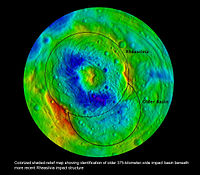Veneneia (crater)
Veneneia (/vɛn[invalid input: 'i-']ˈn[invalid input: 'ee']ə/ ven-i-NEE-ə) is the second-largest crater on asteroid 4 Vesta, at 52°S latitude. 395 kilometres (245 mi)*[1] in diameter, it is 70% of the equatorial diameter of the asteroid, and one of the largest craters in the Solar System. It is at least 2 billion years old.[2] However, it is overlain and partially obliterated by the even larger Rheasilvia. It was discovered by the Dawn spacecraft in 2011. It is named after Venēneia, one of the founding vestal virgins.[3]
Vesta has a series of troughs in the northern hemisphere concentric to Veneneia. These are believed to be large-scale fractures resulting from the impact. The largest is Saturnalia Fossa, approx. 39 km wide and > 400 km long.[4]
References
- ^ 'Vesta seems more planet than asteroid', Science News, 2012 Mar 22
- ^ "Incredible video 'fly-over' by Nasa's Dawn probe reveals huge rippled asteroid Vesta is more like a small planet". Daily Mail, 15 May 2012. Retrieved 23 May 2012.
- ^ Veneneia, Gazetteer of Planetary Nomenclature, 2012 Feb 28 (NASA coordinates)
- ^ EXPLORATION OF SATURNALIA FOSSA AND ASSOCIATED STRUCTURES IN VESTA'S NORTHERN HEMISPHERE


